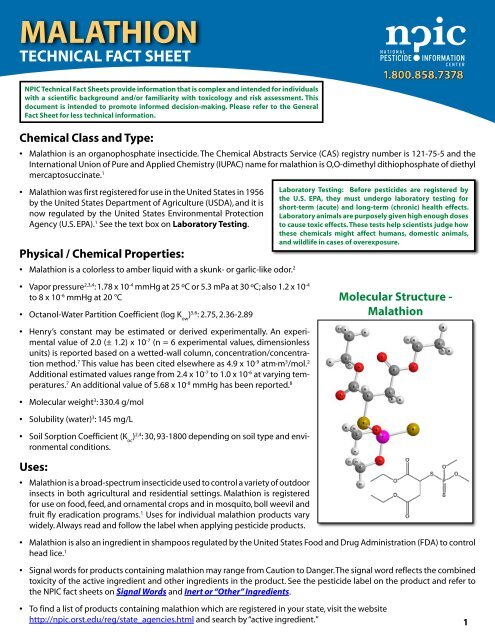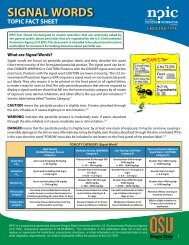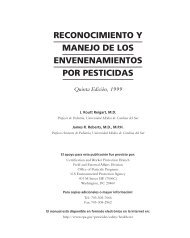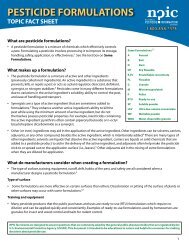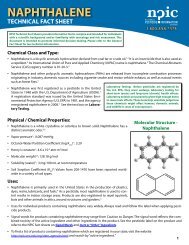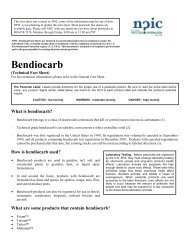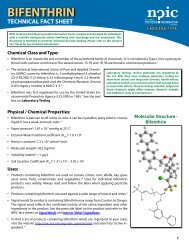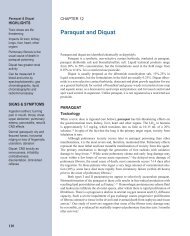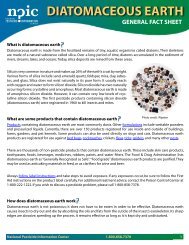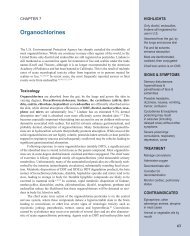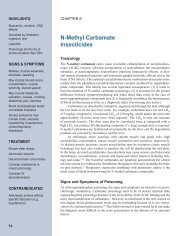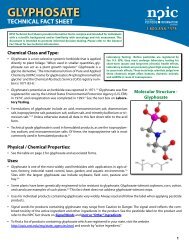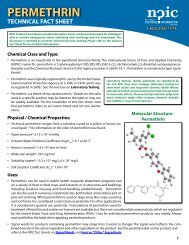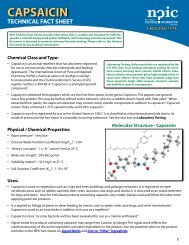Malathion Technical Fact Sheet - National Pesticide Information ...
Malathion Technical Fact Sheet - National Pesticide Information ...
Malathion Technical Fact Sheet - National Pesticide Information ...
Create successful ePaper yourself
Turn your PDF publications into a flip-book with our unique Google optimized e-Paper software.
MALATHION<br />
TECHNICAL FACT SHEET<br />
Chemical Class and Type:<br />
• <strong>Malathion</strong> is an organophosphate insecticide. The Chemical Abstracts Service (CAS) registry number is 121-75-5 and the<br />
International Union of Pure and Applied Chemistry (IUPAC) name for malathion is O,O-dimethyl dithiophosphate of diethyl<br />
mercaptosuccinate. 1<br />
• <strong>Malathion</strong> was first registered for use in the United States in 1956<br />
by the United States Department of Agriculture (USDA), and it is<br />
now regulated by the United States Environmental Protection<br />
Agency (U.S. EPA). 1 See the text box on Laboratory Testing.<br />
Physical / Chemical Properties:<br />
•<br />
•<br />
<strong>Malathion</strong> is a colorless to amber liquid with a skunk- or garlic-like odor.<br />
2,3,4 -4 -4<br />
Vapor pressure : 1.78 x 10 mmHg at 25 ºC or 5.3 mPa at 30 ºC; also 1.2 x 10<br />
to 8 x 10-6 mmHg at 20 °C<br />
• Octanol-Water Partition Coefficient (log Kow<br />
)5,6 : 2.75, 2.36-2.89<br />
• Henry’s constant may be estimated or derived experimentally. An experimental<br />
value of 2.0 (± 1.2) x 10-7 (n = 6 experimental values, dimensionless<br />
units) is reported based on a wetted-wall column, concentration/concentration<br />
method. 7 This value has been cited elsewhere as 4.9 x 10-9 atm·m3 /mol. 2<br />
Additional estimated values range from 2.4 x 10-7 to 1.0 x 10-6 at varying temperatures.<br />
7 An additional value of 5.68 x 10-8 mmHg has been reported. 8<br />
•<br />
•<br />
3 Molecular weight : 330.4 g/mol<br />
3 Solubility (water) : 145 mg/L<br />
• Soil Sorption Coefficient (Koc<br />
)2,4 : 30, 93-1800 depending on soil type and environmental<br />
conditions.<br />
Uses:<br />
• <strong>Malathion</strong> is a broad-spectrum insecticide used to control a variety of outdoor<br />
insects in both agricultural and residential settings. <strong>Malathion</strong> is registered<br />
for use on food, feed, and ornamental crops and in mosquito, boll weevil and<br />
fruit fly eradication programs. 1 Uses for individual malathion products vary<br />
widely. Always read and follow the label when applying pesticide products.<br />
•<br />
<strong>Malathion</strong> is also an ingredient in shampoos regulated by the United States Food and Drug Administration (FDA) to control<br />
head lice. 1<br />
• Signal words for products containing malathion may range from Caution to Danger. The signal word reflects the combined<br />
toxicity of the active ingredient and other ingredients in the product. See the pesticide label on the product and refer to<br />
the NPIC fact sheets on Signal Words and Inert or “Other” Ingredients.<br />
•<br />
NPIC <strong>Technical</strong> <strong>Fact</strong> <strong>Sheet</strong>s provide information that is complex and intended for individuals<br />
with a scientific background and/or familiarity with toxicology and risk assessment. This<br />
document is intended to promote informed decision-making. Please refer to the General<br />
<strong>Fact</strong> <strong>Sheet</strong> for less technical information.<br />
Laboratory Testing: Before pesticides are registered by<br />
the U.S. EPA, they must undergo laboratory testing for<br />
short-term (acute) and long-term (chronic) health effects.<br />
Laboratory animals are purposely given high enough doses<br />
to cause toxic effects. These tests help scientists judge how<br />
these chemicals might affect humans, domestic animals,<br />
and wildlife in cases of overexposure.<br />
To find a list of products containing malathion which are registered in your state, visit the website<br />
http://npic.orst.edu/reg/state_agencies.html and search by “active ingredient.”<br />
2<br />
Molecular Structure -<br />
<strong>Malathion</strong><br />
1
MALATHION<br />
TECHNICAL FACT SHEET<br />
Mode of Action:<br />
Target Organisms<br />
• <strong>Malathion</strong> is toxic via skin contact, ingestion, and inhalation exposure.<br />
• <strong>Malathion</strong> and other organophosphate insecticides bind to the enzyme acetylcholinesterase (AChE) at nerve endings<br />
throughout the bodies of insects and other organisms. 9 Under normal circumstances, AChE binds to the neurotransmitter<br />
acetylcholine (ACh) at the nerve junction, effectively ending the stimulation of the next neuron. When AChE is bound by<br />
malathion’s metabolite malaoxon, ACh accumulates at the nerve junction and results in overstimulation of the nervous<br />
system. 9<br />
•<br />
•<br />
Bioactivation of malathion is necessary for it to exert its toxic effect. Bioactivation is primarily mediated by cytochrome<br />
P450 enzymes in the liver, which create the active metabolite malaoxon through oxidative sulfuration. 5,10<br />
Malaoxon is considered to be 22 times more toxic than the parent malathion from acute dietary exposure and 33 times<br />
more toxic by all routes of exposure from short-term and medium-term exposures. 11<br />
• The organophosphate pesticides, including malathion, share a common mode of action. Exposure to multiple organophosphates<br />
can lead to additive toxicity. However, the different organophosphates vary widely in their potency and how well<br />
they are absorbed by the body depending on the route of exposure. 9<br />
• Storage of malathion products for a long period of time may allow the accumulation of degradation products that inhibit<br />
the liver enzymes responsible for malathion detoxification. 9 Heating malathion may also lead to the formation of isomalathion,<br />
which is a potent AChE inhibitor. 5 See the section on Metabolism for more information.<br />
Non-target Organisms<br />
12 • Acetylcholinesterase is found in mammals, amphibians, fish, reptiles, and birds. In these organisms, the binding of AChE<br />
with malathion allows the accumulation of ACh at the nerve junction. This accumulation of ACh leads to overstimulation of<br />
glandular cells, autonomic ganglia, the central nervous system, and both smooth and skeletal muscles. 9<br />
•<br />
Uptake and metabolism of organophosphates such as malathion are similar in insects and mammals.<br />
• Mammals and birds have greater carboxylesterase activity relative to levels in insects. This enables birds and mammals<br />
to degrade malathion more quickly than it is oxidized to the malaoxon form. Higher vertebrates therefore detoxify and<br />
excrete malathion more readily than do insects. This accounts for the relatively low toxicity of malathion to mammals and<br />
birds. 10,14,15<br />
•<br />
•<br />
Greater carboxylesterase production with consequent increased detoxification of malathion appears to be the underlying<br />
mechanism in resistant insect pests. 15<br />
Microorganisms such as bacteria may use malathion as a source of carbon and phosphorus.<br />
• Plants metabolize malathion to malaoxon although this appears to be a minor pathway, and maloaxon is rapidly eliminated.<br />
5,15 <strong>Malathion</strong> is not expected to be toxic to plants or aquatic algae because its mode of action targets nervous<br />
systems. 1<br />
Acute Toxicity:<br />
Oral<br />
• <strong>Malathion</strong> is very low in toxicity when ingested. The acute rat LD50<br />
is 5400 mg/kg in males and 5700 mg/kg in females.1 The<br />
low toxicity is due to rapid carboxylesterase enzyme metabolism of malathion. 10 See the text boxes on Toxicity Classification<br />
and LD /LC .<br />
50 50<br />
• The acute LD in mice ranges from 400-4000 mg/kg.16,17<br />
50<br />
3<br />
15<br />
13<br />
2
MALATHION<br />
TECHNICAL FACT SHEET<br />
• The acute LD in rats ranged from 1000 to 12,500 mg/kg.16,17<br />
50<br />
Dermal<br />
• <strong>Malathion</strong> is low in toxicity when applied to the skin. The acute<br />
dermal LD in rats is >2000 mg/kg. Based on this value, the U.S.<br />
50<br />
EPA considers malathion to be low in toxicity. 1<br />
• Additional dermal LD values were greater than 4000 mg/kg in<br />
50<br />
rats and 4100-8800 mg/kg in rabbits. 3,16<br />
• In a skin-irritation study, malathion caused slight skin irritation in<br />
rabbits. The U.S. EPA considered malation to be very low in toxicity<br />
based on these results. <strong>Malathion</strong> is not considered a skin<br />
sensitizer based on studies with guinea pigs. 1<br />
•<br />
In an eye-irritation study with rabbits, malathion caused slight eye irritation that cleared within 7 days. The U.S. EPA considered<br />
malathion to be low in toxicity regarding dermal eye irritation. 1<br />
Inhalation<br />
1<br />
• <strong>Malathion</strong> is very low in toxicity when inhaled, with an acute LC in rats of >5.2 mg/L. 50<br />
• Researchers exposed mice to aerosolized technical grade malathion and determined that the LD for the rats and mice<br />
50<br />
combined was 6.9 mg/L for inhalation exposure. 18<br />
• In another study, rabbits and quail were exposed to aerosols of technical grade malathion at concentrations of 6, 34, 65,<br />
and 123 mg/m3 via an ultra low volume spraying apparatus. 19 Quail showed reduced plasma CHe activity after exposure to<br />
concentrations of malathion of 34 mg/m3 or greater, although no quail died and none showed outward signs of toxicity. 19<br />
Signs of Toxicity - Animals<br />
20 • <strong>Malathion</strong> disrupts the cholinergic system, and basic clinical signs will be similar in humans and other mammals. Cholinergic<br />
receptors including the muscarinic, nicotinic, and central nervous system receptors are all affected by exposure to<br />
malathion. 9<br />
Acute Oral<br />
LD 50<br />
Inhalation<br />
LC 50<br />
Dermal<br />
LD 50<br />
Primary Eye<br />
Irritation<br />
Primary Skin<br />
Irritation<br />
TOXICITY CLASSIFICATION - MALATHION<br />
LD 50 /LC 50 : A common measure of acute toxicity is the lethal<br />
dose (LD 50 ) or lethal concentration (LC 50 ) that causes death<br />
(resulting from a single or limited exposure) in 50 percent<br />
of the treated animals. LD 50 is generally expressed as the<br />
dose in milligrams (mg) of chemical per kilogram (kg) of<br />
body weight. LC 50 is often expressed as mg of chemical<br />
per volume (e.g., liter (L)) of medium (i.e., air or water) the<br />
organism is exposed to. Chemicals are considered highly<br />
toxic when the LD 50 /LC 50 is small and practically non-toxic<br />
when the value is large. However, the LD 50 /LC 50 does not<br />
reflect any effects from long-term exposure (i.e., cancer,<br />
birth defects or reproductive toxicity) that may occur at<br />
levels below those that cause death.<br />
High Toxicity Moderate Toxicity Low Toxicity Very Low Toxicity<br />
Up to and including 50 mg/kg<br />
(≤ 50 mg/kg)<br />
Up to and including 0.05 mg/L<br />
(≤ 0.05 mg/L)<br />
(aerosol)<br />
Up to and including 200 mg/kg<br />
(≤ 200 mg/kg)<br />
Corrosive (irreversible destruction of<br />
ocular tissue) or corneal involvement or<br />
irritation persisting for more than 21 days<br />
Corrosive (tissue destruction into the<br />
dermis and/or scarring)<br />
Greater than 50 through 500<br />
mg/kg<br />
(> 50 – 500 mg/kg)<br />
Greater than 0.05 through<br />
0.5 mg/L<br />
(>0.05 – 0.5 mg/L)<br />
Greater than 200 through<br />
2000 mg/kg<br />
(> 200 - 2000 mg/kg)<br />
Corneal involvement or other<br />
eye irritation clearing in 8 –<br />
21 days<br />
Severe irritation at 72 hours<br />
(severe erythema or edema)<br />
Greater than 500 through<br />
5000 mg/kg<br />
(> 500 – 5000 mg/kg)<br />
Greater than 0.5 through 2.0<br />
mg/L<br />
(> 0.5 – 2.0 mg/L)<br />
Greater than 2000 through<br />
5000 mg/kg<br />
(>2000 – 5000 mg/kg)<br />
Corneal involvement or other<br />
eye irritation clearing in 7<br />
days or less<br />
Moderate irritation at 72<br />
hours (moderate erythema)<br />
Greater than 5000 mg/kg<br />
(> 5000 mg/kg)<br />
Greater than 2.0 mg/L<br />
(> 2.0 mg/L)<br />
(dust)<br />
Greater than 5000 mg/kg<br />
(> 5000 mg/kg)<br />
Minimal effects clearing in<br />
less than 24 hours<br />
Mild or slight irritation at<br />
72 hours (no irritation or<br />
erythema)<br />
The highlighted boxes relfect the values in the “Acute Toxicity” section of this fact sheet. Modeled after the U.S. Environmental Protection<br />
Agency, Office of <strong>Pesticide</strong> Programs, Label Review Manual, Chapter 7: Precautionary Labeling. http://www.epa.gov/oppfead1/labeling/lrm/chap-07.pdf<br />
3
MALATHION<br />
TECHNICAL FACT SHEET<br />
• Muscarinic effects resulting from overstimulation of the nervous system, specifically the postganglionic parasympathetic<br />
receptors, include salivation, lacrimation (production of tears), urination and defecation (the SLUD syndrome), vomiting,<br />
dyspnea (shortness of breath), bradycardia (reduced heart rate), abdominal pain, miosis (constriction of the pupils), and<br />
anorexia. 21<br />
•<br />
•<br />
Overstimulation of the nicotinic acetylcholine receptors in the nervous system results in muscle tremors and rigidity, weakness<br />
and loss of limb mobility, and paralysis. 21<br />
Central nervous system overstimulation may lead to depression, anxiety, hyperactivity or restlessness, reduced respiration,<br />
seizures, and coma. 21<br />
• Both organophosphate-induced delayed neuropathy (OPIDN) and Intermediate Syndrome have been reported in animals21<br />
as well as people following very high exposure to some organophosphates (see below). However, no specific information<br />
was found linking malathion exposure in animals or people with either syndrome.<br />
Signs of Toxicity - Humans<br />
• Signs and symptoms of toxic exposure depend on the target enzyme and its sensitivity, the location of the affected synapse,<br />
the level of malaoxon that reaches that synapse, and the route of exposure. 20<br />
•<br />
•<br />
Muscarinic symptoms in humans include excessive perspiration, constriction of the pupils, lacrimation (production of<br />
tears), salivation, abdominal cramps, diarrhea, nausea, vomiting, chest tightness, and difficulty breathing. 9,20,22<br />
Nicotinic symptoms from exposure to malathion can include muscle weakness, muscle cramping or twitching, ataxia, and<br />
paralysis. 9,20,22<br />
• Exposure to malathion may cause blood pressure changes with either rapid or decreased heart rate. Effects on the central<br />
nervous system’s cholinergic neurons can also include headache, confusion, insomnia, decreased rate or depth of respiration,<br />
convulsions, and coma. 9,20,22<br />
• Children may show somewhat different signs than adults following exposure to malathion and other organophosphate<br />
insecticides. Children are less likely to show decreased heart rate, sweating, muscle tremors, and lacrimation than adults,<br />
and more likely to show lethargy, seizures, constricted pupils, excessive salivation, muscle weakness, and coma. 9<br />
• Following exposure to very high doses of some organophosphates including malathion, humans may develop Intermediate<br />
Syndrome. 23,24 The onset is typically 24-96 hours following the exposure. Signs include muscular weakness in the neck,<br />
face, and the upper arms and legs, and partial respiratory paralysis. Depressed tendon reflexes and palsies of the cranial<br />
nerves also occur frequently in this syndrome. 9<br />
• A few organophosphates have been linked to organophosphate-induced delayed neuropathy, or OPIDN, following very<br />
high levels of exposure. OPIDN involves weakness or paralysis of the extremities, particularly the legs. 9 In order for OPIDN<br />
to develop, the enzyme neuropathy target esterase (NTE) must be inhibited permanently. 25 The chemical structure of malathion<br />
suggests that it is unlikely to bind to NTE, and malathion has not bound to NTE in animal models or experimental<br />
animal studies. 25<br />
• Always follow label instructions and take steps to avoid exposure. If any exposures occur, be sure to follow the First Aid<br />
instructions on the product label carefully. For additional treatment advice, contact the Poison Control Center at 1-800-<br />
222-1222. If you wish to report an incident, please call 1-800-858-7378.<br />
4
MALATHION<br />
TECHNICAL FACT SHEET<br />
Chronic Toxicity:<br />
Animals<br />
• Researchers fed dogs malathion for 1 year at doses of 0, 62.5, 125.0,<br />
or 250.0 mg/kg/day. The dogs exhibited plasma and erythrocyte<br />
cholinesterase inhibition at all doses but no clinical signs of toxicity.<br />
A LOAEL was set at 62.5 mg/kg/day for plasma and erythrocyte ChE<br />
inhibition, but no overall ChE NOAEL was established. 26 See the text<br />
box on NOAEL, NOEL, LOAEL, and LOEL.<br />
• In a 21-day dermal study, scientists exposed rabbits to doses of malathion at 0, 50, 300, or 1000 mg/kg/day for six hours/day,<br />
five days/week for three weeks. Scientists detected decreased cholinesterase activity at the two highest doses (300 and<br />
1000 mg/kg/day) but no clinical signs of ChE inhibition. One rabbit died at the highest dose (1000 mg/kg/day). The NOAEL<br />
for cholinesterase inhibition was 50 mg/kg/day. 26<br />
• In a 13-week inhalation study, investigators exposed male and female rats to malathion at concentrations of 0, 0.10, 0.45, or<br />
2.01 mg/L for six hours/day, five days/week for 13 weeks. Investigators noted nasal and larynx lesions at the greatest dose<br />
and measured ChE inhibition at all doses. In addition, signs of cholinesterase inhibition in some animals included excess<br />
salivation, reduced grooming, and red stains around the urogenital areas. The systemic toxicity LOAEL was 0.1 mg/kg/day<br />
but the NOAEL was not established. 14<br />
• Researchers administered malathion at doses of up to 359 mg/kg/day in the diets of male rats or 415 mg/kg/day in the<br />
diets of female rats for two years. Kidney weight gain was noted. The NOAEL for male rats was 29 mg/kg/day and was 35<br />
mg/kg/day for females. 27<br />
Humans<br />
• In an experimental study, five volunteers ingested malathion at up to 16 mg/day (0.23 mg/kg/person/day) for 47 days and<br />
displayed no significant reduction in cholinesterase activity. When consuming 24 mg/day (0.34 mg/kg/day) for 56 days, five<br />
volunteers displayed reduced cholinesterase activity two weeks after the dosing began. A maximum cholinesterase inhibition<br />
of 25% was observed three weeks after the end of the dosing period. 20,28 See the text box on Exposure.<br />
3 • Four male volunteers per treatment inhaled malathion products at 5.3, 21.0, or 85.0 mg/m for one hour per exposure, two<br />
exposures per day for 42 consecutive days. The test subjects reported nasal and eye irritation at the highest dose during<br />
the first 5-10 minutes of each exposure. The authors concluded that no effects on cholinesterase activity occurred, but<br />
noted that one subject in each of the two highest dose groups exhibited reduced plasma cholinesterase activity. 20,29<br />
• Researchers evaluated the health effects associated with treating areas with malathion and diazinon via ground application,<br />
followed by aerial malathion treatments for the control of the Mediterranean fruit fly (Ceratitis capitata). The applications<br />
occurred from April 1998 to September 1998 in an area containing approximately 132,000 people and covering<br />
128 square miles. A total of 6285 gallons of malathion was applied during the 5 month period. There were 230 reports of<br />
pesticide-related illness, and researchers classified 34 as probable and 89 as possible cases. The most commonly reported<br />
signs and symptoms were associated with the respiratory, gastrointestinal, and neurological systems. 30<br />
Endocrine Disruption:<br />
•<br />
NOAEL: No Observable Adverse Effect Level<br />
NOEL: No Observed Effect Level<br />
LOAEL: Lowest Observable Adverse Effect Level<br />
LOEL: Lowest Observed Effect Level<br />
Exposure: Effects of malathion on human health and the environment depend on how much<br />
malathion is present and the length and frequency of exposure. Effects also depend on the<br />
health of a person and/or certain environmental factors.<br />
Researchers noted suppression of thyroid secretory function in young adult rats that were fed 0.06 mg per rat per day of<br />
malathion for 21 days. They also noted an increase in thyroid stimulating hormone (TSH), suggesting that the pituitary<br />
gland was compensating to restore normal levels of thyroid hormones.<br />
5<br />
31
MALATHION<br />
TECHNICAL FACT SHEET<br />
• In another study, researchers observed thyroid effects including an increased prevalence of parathyroid hyperplasia in<br />
male rats. Researchers also reported an increase in thyroid follicular cell adenomas and carcinomas and thyroid c-cell carcinomas<br />
in males only. 14<br />
•<br />
•<br />
Rats that were fed high doses (200 and 400 ppm) of malathion for four weeks showed increased blood glucose levels and<br />
blood insulin concentration. 32<br />
Researchers fed rats 40 mg (approximately 225 mg/kg/day) of malathion for five days and noted decreased pituitary prolactin<br />
levels, increased serum prolactin levels and increased pituitary gland weight. 20,33<br />
• Researchers exposed groups of catfish to 1.2 mg/L malathion for 24 to 96 hours. Investigators noted degenerative changes<br />
to ovary follicle cells, increased levels of damage and abnormalities in the oocytes and reduction in the normal level of<br />
estrogen in blood plasma. 34<br />
• The effects of malathion on the binding of thyroid hormones to the protein transthyretin in blood plasma was studied in<br />
vitro using quail blood plasma. After one hour of incubation with varying concentrations of malathion, free and bound<br />
thyroid hormone levels were measured. The concentration of malathion necessary to inhibit 3,3',5- -triiodothyronine (T3)<br />
L<br />
by 50% (IC ) was 1400 ± 370 nM. 50 35<br />
• <strong>Malathion</strong> is listed in the first group of substances to be tested as part of the U.S. EPA Endocrine Disruptor Screening Program<br />
(EDSP) because of the potential for people to be exposed to malathion. However, inclusion in the list does not infer<br />
that malathion is either known or suspected to be an endocrine disruptor. 36<br />
Carcinogenicity:<br />
Animals<br />
• Evidence of the carcinogenicity of malathion in animals is mixed. Several studies have been conducted with rats and mice<br />
to determine whether malathion has the potential to cause cancer with variable results.<br />
•<br />
•<br />
•<br />
•<br />
•<br />
In a study involving long-term dietary exposures to malathion, researchers observed an increased incidence of liver and<br />
nasal/oral tumors in rats and increased incidence of liver tumors in mice. 14<br />
In an 80-week dietary study in rats, researchers administered malathion at doses of 0, 359, and 622 mg/kg/day. Investigators<br />
did not find statistically significant evidence of carcinogenicity. 37<br />
Researchers administered dietary doses of 0, 166, or 332 mg/kg/day to rats for 103 weeks. Investigators concluded that<br />
there was no evidence that malathion was carcinogenic to rats. 38<br />
Researchers conducted an 80-week dietary study in mice with doses of 0, 1490, or 2980 mg/kg/day of malathion. They<br />
found no evidence of an association between tumor incidence and exposure to malathion. 37<br />
In a two-year dietary study, researchers administered oral doses of 2, 359, 739, or 868 mg/kg/day to rats. They found a statistically<br />
significant increase in liver adenomas and carcinomas in females at the highest dose tested. 27<br />
• In a bioassay in mice, researchers administered malathion at doses ranging from 17.4 to 3448.0 mg/kg/day. They concluded<br />
that there was evidence of carcinogenicity at doses of 1476 and 2978 mg/kg/day in males and 1707 and 3448 mg/kg/day<br />
in females based on incidences of hepatocellular adenomas and liver carcinomas. 39 <strong>Information</strong> on specific dose levels was<br />
not available.<br />
Humans<br />
• The International Agency for Research on Cancer (IARC) concluded in 1987 that the carcinogenic potential of malathion<br />
was not classifiable, and placed it in Group 3. 40<br />
6
MALATHION<br />
TECHNICAL FACT SHEET<br />
• The U.S. EPA classifies malathion as “suggestive evidence of carcinogenicity but not sufficient to assess human carcinogenic<br />
potential by all routes of exposure”. This classification was based on the occurrence of liver tumors at excessive doses in<br />
mice and female rats and the presence of rare oral and nasal tumors in rats that occurred following exposure to very large<br />
doses. 14 See the text box on Cancer.<br />
• Researchers conducted a study involving participants from six Canadian provinces and found that exposure to organophosphates<br />
as a group and malathion alone was associated with non-Hodgkin’s lymphoma. <strong>Malathion</strong> used as a fumigant<br />
was not associated with increased cancer risk. 41<br />
• Between 1993 and 1997, as part of the Agricultural Health Study, researchers surveyed 19,717 pesticide applicators about<br />
their past pesticide exposures and health histories. No clear association between malathion exposure and cancer was reported.<br />
42<br />
Reproductive or Teratogenic Effects:<br />
Animals<br />
• In a developmental neurotoxicity study in rats, researchers administered malathion orally at doses of 0, 5, 50, or 150 mg/kg/<br />
day to pregnant rats from gestation day 6 to postnatal day 10. Their offspring were then administered the same doses of<br />
malathion from postnatal day 11 to postnatal day 21. Increases in startle response were noted in the offspring at all doses<br />
tested. Researchers noted abnormal gait at 50 and 150 mg/kg/day and reduced reflex response in female rats at 150 mg/<br />
kg/day. 14<br />
•<br />
Researchers conducted prenatal developmental toxicity studies with malathion in rats and did not observe any developmental<br />
toxicity at maternal doses of up to 800 mg/kg/day. 14<br />
• In a study of pregnant rabbits, researchers noted decreased maternal body weight and an increase in the incidence of fetus<br />
resorption at or above 50 mg/kg/day of malathion. 14<br />
• <strong>Malathion</strong> did not affect reproductive function in female rats in a two-generation reproduction study. However, researchers<br />
observed effects on pre-weaning pup growth at doses of 394-451 mg/kg/day. These doses were not toxic to the mothers.<br />
Cholinesterase activity was not measured. 14<br />
•<br />
<strong>Malathion</strong> and/or its metabolites were transferred across the placenta and affected the plasma cholinesterase activity of<br />
rabbit fetuses when the mothers were orally dosed with 180 mg/kg malathion for three consecutive days. 43<br />
• In a postnatal study in mice, dams were given daily injections of malathion at concentrations of 20, 60, and 200 mg/kg<br />
during the entire lactation period (21 days). Brain acetylcholinesterase in the dams was significantly decreased only at the<br />
highest dose tested, but offspring showed significant reduction in brain acetylcholinesterase activity at all doses tested. 44<br />
•<br />
Cancer: Government agencies in the United States and abroad have developed programs to evaluate the<br />
potential for a chemical to cause cancer. Testing guidelines and classification systems vary. To learn more<br />
about the meaning of various cancer classification descriptors listed in this fact sheet, please visit the<br />
appropriate reference, or call NPIC.<br />
Researchers exposed pig sperm to malathion for one hour at concentrations of 50, 100, and 500 µM. Sperm viability was<br />
reduced at the two highest doses, and motility was reduced following exposure to malathion at all doses. 45<br />
Humans<br />
• No data were found on developmental or reproductive effects of malathion in humans.<br />
7
MALATHION<br />
TECHNICAL FACT SHEET<br />
Fate in the Body:<br />
Absorption<br />
• After oral exposure, malathion is rapidly absorbed by the body.<br />
•<br />
<strong>Malathion</strong> is readily absorbed through the skin, although the percent of a dose that is absorbed varies depending on the<br />
size of the dose and site of exposure. 20<br />
• Researchers applied malathion to skin of male human volunteers at various points of their body, including forearm, axilla<br />
(armpit), ball of the foot, abdomen, forehead, and jaw angle. Absorption was greatest in the armpit followed by the forehead.<br />
Absorption through skin in the armpit and forehead areas was 4.2 and 3.4 times greater respectively than absorption<br />
by forearm skin. 46<br />
•<br />
<strong>Malathion</strong> is expected to be readily absorbed when the vapor or spray mist is inhaled.<br />
Distribution<br />
• Researchers administered malathion orally to one group of male rats at 28 mg/kg, and dermally to another group at 41 mg/<br />
kg. In both cases, more than 90% of the dose was excreted in urine within 24 hours. The remaining malathion was found in<br />
feces, blood, intestines, liver, and kidneys. 47<br />
• Researchers applied malathion to rats either intravenously, orally or dermally. Thirty minutes after intravenous exposure<br />
most of the malathion was in the liver, kidneys, small intestine, urinary tract and lungs. Four hours after oral administration,<br />
75% of the malathion was still in the stomach, while 8% was in the small intestines, and 7% in the saliva. Eight hours after<br />
dermal application, 28% of the dose was still on the applied site, 29% had spread to untreated skin, and 23% had been<br />
absorbed and travelled to the small intestine and urinary bladder cavity. 48<br />
•<br />
Based on organ weight changes during a two-week inhalation study in rats, other target organs for malathion are the liver<br />
and kidney. 26<br />
Metabolism<br />
• Researchers detected 10 metabolites in the urine and feces of rats following dosing with radiolabeled malathion. Urine<br />
contained mostly the malathion dicarboxylic acid and lesser concentrations of the α- and α-malathion mono acids; these<br />
three compounds comprised 80% of the radiolabel. Minor metabolites included malaoxon, desmethyl malathion, O,Odimethyl<br />
phosphorothioate, monoethyl fumarate, O,O-dimethyl phosphorodithioate, and thiomalic acid. 5<br />
•<br />
•<br />
Metabolites detected in humans were essentially the same as in rats, except monomethyl and dimethyl phosphate were<br />
found in humans, but thiomalic acid and monoethyl fumarate were not. 5<br />
In a metabolism study conducted on rats, malathion did not bioaccumulate in any of the organs or tissues analyzed. The<br />
parent compound made up the majority of the excreted residue. 14<br />
• Certain impurities in malathion products can potentiate the toxicity of malathion by inhibiting the carboxylesterases that<br />
metabolize malathion and malaoxon in the body. 13 These impurities may form during the manufacturing process or after<br />
long periods of storage. 20<br />
•<br />
Storage of malathion at high temperatures may also lead to the formation of isomalathion, which is much more toxic than<br />
malathion itself. Isomalathion is a potent AChE inhibitor. 5<br />
14 • Both malathion and malaoxon are broken down into water-soluble compounds by carboxylesterase enzymes. These<br />
enzymes are found in various organs in rats, including the liver, blood serum, and kidney. In humans however, the liver<br />
contains the greatest carboxylesterase activity, but the enzyme is absent in the blood. 20<br />
20<br />
20<br />
8
MALATHION<br />
TECHNICAL FACT SHEET<br />
• Animals metabolize malathion into the α- and β-malathion monocarboxylic acids via de-esterification, and these compounds<br />
are further broken down into dicarboxylic acid. 5 Secondary metabolic pathways include oxidative desulfuration to<br />
malaoxon, hydrolysis to phosphatases, and dealkylation to desmethylmalathion. 5<br />
•<br />
In insects, resistance to malathion appears to be due to the ability to induce greater levels of carboxylesterase activity. Reduced<br />
absorption and increased excretion rates may also play a role in resistance. 5<br />
Excretion<br />
• In a metabolism study conducted on rats, orally administered malathion was excreted primarily in the urine (80- 90%)<br />
within the first 24 hours following exposure. Unchanged malathion was the primary residue. 14<br />
• Researchers observed ten different metabolites of malathion in the urine of rats dosed with an unspecified concentration<br />
of radio-labeled compound. A total of 85-89% of the dose was excreted in urine, whereas 4-15% of the dose was excreted<br />
in feces in the first 72 hours. 5<br />
2 • <strong>Malathion</strong> was applied to the ventral forearm skin of eight human male volunteers at 4 µg/cm . Excretion of the parent<br />
compound peaked 4-8 hours following the dosing, although only 8% of the applied dose was recovered in urine over the<br />
120 hour post-application period. 49 Researchers applied the same dose of malathion to skin at various sites of the body in<br />
another study. Excretion through urine was greatest following application to skin of the axilla (armpit) and forehead, with<br />
28.6 ± 13.7% and 23.1 ± 9.1% of the original dose recovered, respectively. 46<br />
•<br />
50 <strong>Malathion</strong> has been detected in human breast milk, although no studies were found that examined the relationship to<br />
exposure or if its presence could cause adverse effects in nursing infants.<br />
Medical Tests and Monitoring:<br />
• There are tests available to determine whether exposure to malathion has occurred. Metabolic products can be measured<br />
in urine, if the test is conducted within a few days of exposure. 20 However, the presence of malathion metabolites in urine<br />
does not necessarily indicate an exposure level great enough to cause adverse health effects. 52 In addition, presence of<br />
metabolites may also result from exposure to the metabolites through diet or from the environment, not from direct exposure<br />
to the parent compound. 51<br />
• A blood test may be taken to measure cholinesterase levels in the blood relative to a person’s normal level. This type of<br />
test is not specific to malathion, and can be used to determine exposure to any cholinesterase inhibitor. However, normal<br />
baseline levels of cholinesterase vary widely and can also be suppressed by other factors such as disease. 9<br />
• In animals, whole blood, stomach contents, hair, or vomitus may be evaluated by submitting samples for laboratory screening<br />
for AChE activity. Reduced AChE activity may indicate that exposure to malathion or other organophosphate or carbamate<br />
pesticides may have occurred. 21<br />
Environmental Fate:<br />
Soil<br />
52,53 • Reported half-lives in soil range from 1 to 17 days. See the text box on Half-life on page 10.<br />
• The extractable residues of malathion in the soil decline rapidly due to volatilization, binding to soil, uptake by plants, and<br />
metabolism by soil microbes. Bound residues peaked at 42% of the applied dose 200 hours following application in laboratory<br />
studies. 53<br />
• Although malathion may be degraded by chemical processes in soil such as chemical hydrolysis, the amount of microbial<br />
degradation is far greater than chemical degradation in natural systems. 15<br />
9
MALATHION<br />
TECHNICAL FACT SHEET<br />
• <strong>Malathion</strong> is considered to be very mobile in most soil types, including<br />
sand, loam, sandy loam, and silt loam soils. 20<br />
• Malaoxon is the primary metabolite of malathion under certain abiotic<br />
environmental conditions. Malaoxon may form from environmental<br />
degradation of the parent compound, particularly if malathion<br />
is deposited on hard, dry surfaces. 1 Malaoxon formation may<br />
be greater on dry soils. 54<br />
• Malaoxon is less stable than malathion and can be quickly degraded<br />
to non-toxic metabolites. 15 Malaoxon is a minor metabolite of malathion<br />
in soil. 55<br />
Water<br />
• Chemical degradation in water is a function of both pH and temperature.<br />
<strong>Malathion</strong>’s half-life in double-deionized water was greatest at<br />
pH 4 and decreased rapidly with either increasing or decreasing pH. The researchers concluded that elimination reactions<br />
predominate at high temperatures and carboxyl ester hydrolysis reactions predominate at lower temperatures. 56<br />
The “half-life” is the time required for half of the<br />
compound to break down in the environemnt.<br />
1 half-life = 50% remaining<br />
2 half-lives = 25% remaining<br />
3 half-lives = 12% remaining<br />
4 half-lives = 6% remaining<br />
5 half-lives = 3% remaining<br />
Half-lives can vary widely based on environmental<br />
factors. The amount of chemical remaining after a<br />
half-life will always depend on the amount of the<br />
chemical originally applied. It should be noted that<br />
some chemicals may degrade into compounds of<br />
toxicological significance.<br />
•<br />
The half-life of malathion in water was estimated as 1.65 days at pH 8.16 and 17.4 days at pH 6.0.<br />
• Based on the K values, malathion is expected to exist primarily in the water column and not bind to sediments.58<br />
oc<br />
• <strong>Malathion</strong> may dissolve in rainwater and be carried in runoff from the application site. U.S. EPA monitoring data from the<br />
Boll Weevil Eradication Program and the Mediterranean fruit fly control programs indicate that malathion concentrations<br />
in runoff water decrease as distance from the application site increases. 1<br />
• <strong>Malathion</strong>’s half-life in sediments from two creeks in Southern California were 0.8-1.4 days under aerobic conditions and<br />
1.6-2.3 days under anaerobic conditions. The presence of oxygen affected the degradation rate in one sediment type but<br />
not the other. 58<br />
•<br />
•<br />
Of the 990 wells sampled for the U.S. EPA’s groundwater database (1971-1991), 12 had positive detections of malathion.1<br />
The USDA’s <strong>Pesticide</strong> Data Program (PDP) found no residues of malathion or malaoxon in any of the bottled water or drinking<br />
water samples tested in 2006. 59<br />
• Researchers tested 12 community water systems and detected malathion in 5 of 228 samples prior to standard water treatment.<br />
No malathion was detected in the finished water. 60 All malathion entering treatment facilities with surface water is<br />
expected to be converted to malaoxon by the end of the treatment process based on monitoring data. 14<br />
• <strong>Malathion</strong> was found in surface water in both urban and agricultural settings during a survey of surface and groundwater<br />
conducted by the United States Geological Survey (USGS) from 1992 to 2001. In urban streams, malathion was detected in<br />
15% of water samples and was responsible for 30% of the incidents where pesticide concentrations were found at levels<br />
exceeding the aquatic-life benchmark dose. 61 <strong>Malathion</strong> was commonly found in mixtures in urban streams. It also occurred<br />
in surface waters in agricultural areas although it was not detected in groundwater. 61<br />
•<br />
•<br />
•<br />
Malaoxon was found to undergo most rapid hydrolysis at pH 10.<br />
Microbial degradation was implicated in the degradation of malathion in seawater.<br />
Photodegradation of malathion in deionized water led to the formation of nine degradation products, primarily butane(a)<br />
ne diethyl esters. The half-life of malathion during this process was estimated to be 11.6 minutes. 64<br />
62<br />
63<br />
57<br />
10
MALATHION<br />
TECHNICAL FACT SHEET<br />
Air<br />
• <strong>Malathion</strong> in the vapor phase can be degraded by hydroxyl radicals created by sunlight or by photolysis.<br />
3 • <strong>Malathion</strong> was detected in very low concentrations in air (
MALATHION<br />
TECHNICAL FACT SHEET<br />
• Studies of wild bird populations following use of malathion in grasshopper control programs concluded that there were<br />
either no effects or inconsistent effects of treatment on reproduction and survival. 77,78 Bird densities were lower several<br />
weeks after treatment in one study, as were grasshopper densities; the researchers concluded that reduced food availability<br />
was the most plausible reason for the declines in bird densities. 78<br />
Fish and Aquatic Life<br />
• <strong>Malathion</strong> is highly toxic to bluegill sunfish ( Lepomis macrochirus) and large-mouth bass with 96-hour LC of 0.10 mg/L<br />
50<br />
and 0.28 mg/L, respectively. 3 It is moderately toxic to the snakehead fish (Channa punctatus) and mosquitofish (Gambusia<br />
affinis) with a 96-hour LC of 6.60 ppm and a 48-hour LC of 1.23 mg/L, respectively. 50 50 69,70<br />
• Researchers exposed larvae of the estuarine fish red drum ( Sciaenops<br />
ocellatus) to environmentally realistic and sublethal levels<br />
of malathion at levels of 0, 1, and 10 µg/L for up to seven days.<br />
No adverse effects were recorded. 71<br />
• The 48-hour EC50<br />
for Daphnia is 1.0 µg/L.3 See the text box on<br />
EC50. • Estimated LC values for six species of North American tadpoles<br />
50<br />
ranged from 1.2-5.9 mg/L for a 16-day exposure. Water was<br />
changed once every 4 days to maintain nominal concentrations. 72<br />
• Bullfrog tadpoles were exposed to a constant, high level of malathion for 28 days. At concentrations of 1000 µg/L and<br />
higher, tadpole development was delayed, and at 2500 µg/L and higher, survival decreased. These levels are higher than<br />
those observed in the environment following normal use of malathion. 73<br />
• Researchers applied malathion to aquatic mesocosms containing phytoplankton, zooplankton, periplankton, and tadpoles<br />
from two species of frogs. One treatment consisted of weekly applications of 10 µg/L of malathion, others of single applications<br />
of 50 or 250 µ/L. Although zooplankton recovered following single-dose exposures, time to metamorphosis in the<br />
tadpoles increased and their mass at metamorphosis declined following both the pulsed and single exposures. 74<br />
• Other aquatic mesocosm experiments have documented altered aquatic community structure and altered predator-prey<br />
relationships following exposure to malathion at concentrations of 0.25, 0.50, or 1.00 mg/L. 75 Short-term community effects<br />
following exposure to 0.32 mg/L included a loss of 30% of the total animal species richness. 76<br />
Terrestrial Invertebrates<br />
• <strong>Malathion</strong> is highly toxic to bees, whether from direct contact, contact with foliar residues, or contact with residues on pollen.<br />
The honey bee topical LD is 0.71 µg/bee. 50 3<br />
•<br />
<strong>Malathion</strong> is toxic to other beneficial insect species, and very highly toxic to aquatic invertebrates.<br />
• The LC for worms is 613 mg/kg of soil.3<br />
50<br />
Regulatory Guidelines:<br />
• The U.S. EPA has established an acute Reference Dose<br />
(RfD) of 0.14 mg/kg/day for the general population<br />
based on a study comparing ChE levels in rats. 14 See the<br />
text box on Reference Dose (RfD).<br />
•<br />
EC 50 : The median effective concentration (EC 50 ) may be<br />
reported for sublethal or ambiguously lethal effects. This<br />
measure is used in tests involving species such as aquatic<br />
invertebrates where death may be difficult to determine.<br />
This term is also used if sublethal events are being<br />
monitored.<br />
Newman, M.C.; Unger, M.A. Fundamentals of Ecotoxicology; CRC Press, LLC.:<br />
Boca Raton, FL, 2003; p 178.<br />
Reference Dose (RfD): The RfD is an estimate of the quantity of<br />
chemical that a person could be exposed to every day for the rest<br />
of their life with no appreciable risk of adverse health effects. The<br />
reference dose is typically measured in milligrams (mg) of chemical<br />
per kilogram (kg) of body weight per day.<br />
U.S. Environmental Protection Agency, Technology Transfer Network, Air Toxics Health<br />
Effects Glossary, 2009. http://www.epa.gov/ttnatw01/hlthef/hapglossaryrev.html#RfD<br />
The U.S. EPA established a benchmark dose level of 7.1 mg/kg based on studies of rats and used this to determine the<br />
chronic RfD of 0.07 mg/kg/day.<br />
12<br />
14<br />
1,3
MALATHION<br />
TECHNICAL FACT SHEET<br />
•<br />
•<br />
•<br />
•<br />
•<br />
•<br />
14 The U.S. EPA classifies malathion as having “suggestive evidence of carcinogenicity”. See the text box on Cancer (page 7).<br />
Based on a 2-year dietary study in which rats showed inhibition of ChE activity, malathion has a chronic Minimum Risk<br />
Level (MRL) of 0.02 mg/kg/day. 27<br />
The U.S. EPA has established an acute population adjusted dose (aPAD) of 0.14 mg/kg/day and a chronic population adjusted<br />
dose (cPAD) of 0.07 mg/kg/day. 1<br />
The workplace permissible exposure limit (PEL) for malathion established by the Occupational Safety and Health Administration<br />
(OSHA) is 15 mg/m3 , for an 8-hour workday, 40 hours per week. 20<br />
The workplace recommended exposure limit (REL) established by the <strong>National</strong> Institute for Occupational Safety and Health<br />
(NIOSH) is 10 mg/m3 , for a 10-hour workday, 40 hours per week. 20<br />
NIOSH has also established the level of malathion in the air that is immediately dangerous to life and health (IDLH) be set<br />
at 250 mg/m3 . 20<br />
Date Reviewed: August 2009<br />
Please cite as: Gervais, J. A.; Luukinen, B.; Buhl, K.; Stone, D. 2009. <strong>Malathion</strong> <strong>Technical</strong> <strong>Fact</strong> <strong>Sheet</strong>; <strong>National</strong> <strong>Pesticide</strong><br />
<strong>Information</strong> Center, Oregon State University Extension Services. http://npic.orst.edu/factsheets/malatech.pdf.<br />
References<br />
1. Reregistration Eligibility Decision (RED) for <strong>Malathion</strong>; EPA 738-R-06-030; U.S Environmental Protection Agency, Office of<br />
Prevention, <strong>Pesticide</strong>s and Toxic Substances, Office of <strong>Pesticide</strong> Programs, U.S. Government Printing Office: Washington,<br />
DC, 2006.<br />
2. Hazardous Substances Databank (HSDB), <strong>Malathion</strong>; U.S. Department of Health and Human Services, <strong>National</strong> Institutes<br />
of Health, <strong>National</strong> Library of Medicine. http://toxnet.nlm.nih.gov/cgi-bin/sis/htmlgen?HSDB (accessed Jan 2008),<br />
updated June 2005.<br />
3. Tomlin, C. D. S., The <strong>Pesticide</strong> Manual, A World Compendium. 14th ed.; British Crop Protection Council: Alton, Hampshire,<br />
UK, 2006; pp 642-643.<br />
4. Hornsby, A. G. Wauchope, R. D. Herner, A. E. <strong>Pesticide</strong> Properties in the Environment; Springer-Verlag: New York, 1996.<br />
5. Roberts, T. R. Metabolic Pathways of Agrochemicals - Part 2: Insecticides and Fungicides; The Royal Society of Chemistry:<br />
Cambridge, UK, 1998; pp 360-367.<br />
6. Suntio, L. R.; Shiu, W. Y.; Mackay, D.; Seiber, J. N.; Glotfelty, D. E. Critical review of Henry’s law constants for pesticides. Rev.<br />
Environ. Contam. Toxicol. 1988, 103, 1-59.<br />
7. Fendinger, N. J.; Glotfelty, D. E. Henry’s law constants for selected pesticides, PAHs and PCBs. Environ. Toxicol. Chem. 1990,<br />
9, 731-735.<br />
8. Sanders, P. F.; Seiber, J. N. A chamber for measuring volatilization of pesticides from model soil and water disposal<br />
systems. Chemosphere 1983, 12 (7/8), 999-1012.<br />
9. Reigart, J. R.; Roberts, J. R. Organophosphate Insecticides. Recognition and Management of <strong>Pesticide</strong> Poisonings, 5th<br />
ed.; U.S Environmental Protection Agency, Office of Prevention, <strong>Pesticide</strong>s and Toxic Substances, Office of <strong>Pesticide</strong><br />
Programs, U.S. Government Printing Office: Washington, DC, 1999; pp 34-47.<br />
10. Costa, L. G. Toxic effects of pesticides. Casarett and Doull’s Toxicology: The Basic Science of Poisons, 7th ed.; Klaassen, C. D.,<br />
Ed.; McGraw Hill Medical: New York, 2008; pp 883-930.<br />
13
MALATHION<br />
TECHNICAL FACT SHEET<br />
11. Revised Reregistration Eligibility Decision (RED) for <strong>Malathion</strong>; EPA 738-R-06-030; U.S Environmental Protection Agency,<br />
Office of Prevention, <strong>Pesticide</strong>s and Toxic Substances, Office of <strong>Pesticide</strong> Programs, U.S. Government Printing Office:<br />
Washington, DC, 2009.<br />
12. Massoulie, J.; Bon, S. The molecular forms of cholinesterase and acetylcholinesterase in vertebrates. Annu. Rev. Neurosci.<br />
1982, 5, 57-106.<br />
13. WHO. Environmental Health Criteria 63, Organophosphate Insecticides: A General Introduction; International Programme<br />
on Chemical Safety, World Health Organization: Geneva, Switzerland, 1986.<br />
14. <strong>Malathion</strong>:<br />
Revised human health risk assessment for the reregistration eligibility decision document (RED); EPA-HQ-<br />
OPP-2004-0348-0057; U.S. Environmental Protection Agency, Office of Prevention, <strong>Pesticide</strong>s and Toxic Substances,<br />
Office of <strong>Pesticide</strong> Programs, U.S. Government Printing Office: Washington, DC, 2006.<br />
15. Mulla, M. S.; Mian, L. S.; Kawecki, J. A. Distribution, transport, and fate of the insecticides malathion and parathion in the<br />
environment. Residue Reviews; Gunther, F. A.; Gunther, J. D., Eds.; Springer-Verlag: New York, 1981.<br />
16. Kamrin, M. A. <strong>Pesticide</strong> Profiles: Toxicity, Environmental Impact, and Fate; Lewis Publishers: New York, 1997; pp 191-195.<br />
17. Gallo, M. J.; Lawryk, N. J. Organic phosphorus pesticides. Handbook of <strong>Pesticide</strong> Toxicology; Hayes Jr., W. J.; Laws Jr., E. R.,<br />
Eds.; Academic Press, Inc.: San Diego, 1991; pp 917-1123.<br />
18. Berteau, P. E.; Deen, W. A. A comparison of oral and inhalation toxicities of four insecticides to mice and rats. Bull. Environ.<br />
Contam. Toxicol. 1978, 19 (1), 113-120.<br />
19. Weeks, M. H.; Lawson, M. A.; Angerhofer, R. A.; Davenport, C. D.; Pennington, N. E. Preliminary assessment of the acute<br />
toxicity of malathion in animals. Arch. Environ. Contam. Toxicol. 1977, 6, 23-31.<br />
20. Toxicological Profile for <strong>Malathion</strong>; U.S. Department of Health and Human Services, Agency for Toxic Substances and<br />
Disease Registry: Atlanta, 2008.<br />
21. Blodgett, D. J. Organophosphate and carbamate insecticides. Small Animal Toxicology, 2nd ed.; Peterson, M. E.; Talcott, P.<br />
A. Eds.; Elsevier Saunders: Saint Louis, 2006; pp 941-953.<br />
22. Wagner, S. L. Diagnosis and treatment of organophosphate and carbamate intoxication. Occup. Med.: State of the Art<br />
Reviews. 1997, 12 (2), 239-249.<br />
23. Sudakin, D. L.; Mullins, M. E.; Horowitz, B. Z.; Abshier, V.; Letzig, L. Intermediate syndrome after malathion ingestion<br />
despite continuous infusion of pralidoxime. Clin. Toxicol. 2000, 38 (1), 47-50.<br />
24. Lee, P.; Tai, D. Y. H. Clinical features of patients with acute organophosphate poisoning requiring intensive care. Intensive<br />
Care Med. 2001, 27, 694-699.<br />
25. Insecticide Toxicology. Gulf War and Health Volume 2: Insecticides and Solvents; <strong>National</strong> Academy of Sciences, Institute of<br />
Medicine, The <strong>National</strong> Academies Press: Washington, DC, 2003; pp 43-46, 69-81.<br />
26. <strong>Malathion</strong>:<br />
Updated Revised Human Health Risk Assessment for the Reregistration Eligibility Decision Document (RED); EPA-<br />
HQ-OPP-2004-0348-0004; U.S. Environmental Protection Agency, Office of Prevention, <strong>Pesticide</strong>s and Toxic Substances,<br />
Office of <strong>Pesticide</strong> Programs, U.S. Government Printing Office: Washington, DC, 2005.<br />
27. Daly, I. A 24-month oral toxicity/oncogenicity study of malathion in the rat via dietary administration. Final report: Lab<br />
project No. 90-3641.1996. Unpublished study prepared by Huntington Life Sciences. EPA MRID 43942901. Toxicological<br />
Profile for <strong>Malathion</strong>; U.S Department of Health and Human Services, Agency for Toxic Substances and Disease Registry,<br />
Public Health Service: Atlanta, 2003.<br />
28. Moeller, H. C.; Rider, J. A. Plasma and red blood cell cholinesterase activity as indications of the threshold of incipient<br />
toxicity of ethyl-p-nitrophenyl thionobenzenephosphonate (EPN) and malathion in human beings. Toxicol. Appl.<br />
Pharmacol. 1962, 4, 123-130.<br />
29. Golz, H. H. Controlled human exposures to malathion aerosols. AMA Arch. Ind. Health 1959, 19, 53-59.<br />
14
MALATHION<br />
TECHNICAL FACT SHEET<br />
30. CDC. Surveillance for Acute <strong>Pesticide</strong>-Related Illness during the Medfly Eradication Program - Florida, 1998. Morbidity<br />
and Mortality Weekly Report; U.S Department of Health and Human Services, Centers for Disease Control and<br />
Prevention: Atlanta, 1999; Vol. 48, No. 44, pp 1015-1018,1027.<br />
31. Akhtar, N.; Kayani, S.; Ahmad, M.; Shahab, M. Insecticide-induced changes in secretory activity of the thyroid gland in<br />
rats. J. Appl. Toxicol. 1996, 16 (5), 397-400.<br />
32. Pournourmohammadi, S.; Farzami, B.; Ostad, S. N.; Azizi, E.; Abdollahi, M. Effects of malathion subchronic exposure on rat<br />
skeletal muscle glucose metabolism. Environ. Toxicol. Pharmacol. 2005, 19, 191-196.<br />
33. Simionescu, L.; Oprescu, M.; Sahleanu, V.; Dimitriu, V.; Ghinea, E. The serum and pituitary prolactin variations under the<br />
influence of a pesticide substance in the male rat. Rev. Roum. Med. 1977, 15 (3), 181-188.<br />
34. Dutta, H. M.; Nath, A.; Adhikari, S.; Roy, P. K.; Singh, N. K.; Munshi, J. S. D. Sublethal malathion induced changes in the ovary<br />
of an air-breathing fish, Heteropneustes fossilis: a histological study. Hydrobiologia 1994, 294 (3), 215-218.<br />
35. Ishihara, A.; Nishiyama, N.; Sugiyama, S.-i.; Yamauchi, K. The effect of endocrine disrupting chemicals on thyroid hormone<br />
binding to Japanese quail transthyretin and thyroid hormone receptor. Gen. Comp. Endocrinol. 2003, 134 (1), 36-43.<br />
36. Draft List of Initial <strong>Pesticide</strong> Active Ingredients and <strong>Pesticide</strong> Inerts to be Considered for Screening Under the Federal<br />
Food, Drug, and Cosmetic Act. Fed. Regist. June 18, 2007, 72 (116), 33486-33503.<br />
37. NCI, Bioassay of malathion for possible carcinogenicity. CARCINOGENESIS <strong>Technical</strong> Report Series No. 24; U.S. Department<br />
of Health, Education and Welfare, Public Health Service, <strong>National</strong> Institutes of Health, <strong>National</strong> Cancer Institute:<br />
Bethesda, MD, 1978; pp 19-35.<br />
38. NCI, Bioassay of malathion for possible carcinogenicity. CARCINOGENESIS <strong>Technical</strong> Report Series No. 192; U.S.<br />
Department of Health, Education, and Welfare, Public Health Service, <strong>National</strong> Institutes of Health, <strong>National</strong> Cancer<br />
Institute: Bethesda, MD, 1979; pp 17-32.<br />
39. Slauter, R. W. 18 month oral (dietary) oncogenicity study in mice: <strong>Malathion</strong>. Lab project No. 668-001. Unpublished study<br />
prepared by International Research and Development Corporation, Mattawan, MI. EPA MRID 43407201. Toxicological<br />
Profile for <strong>Malathion</strong>; U.S. Department of Health and Human Services, Agency for Toxic Substances and Disease Registry,<br />
Public Health Service: Atlanta, 1994.<br />
40. Miscellaneous <strong>Pesticide</strong>s. IARC Monographs on the Evaluation of Carcinogenic Risks to Humans; International Agency for<br />
Research on Cancer: Lyon, France, 1998; Vol. 30, p 103.<br />
41. McDuffie, H. H.; Pahwa, P.; McLaughlin, J. R.; Spinelli, J. J.; Fincham, S.; Dosman, J. A.; Robson, D.; Skinnider, L. F.; Chio, N. W.<br />
Non-Hodgkin’s lymphoma and specific pesticide exposures in men: cross-Canada study of pesticides and health. Cancer<br />
Epidemiol. Biomarkers Prev. 2001, 10, 1155-1163.<br />
42. Bonner, M. R.; Coble, J.; Blair, A.; Freeman, L. E. B.; Hoppin, J. A.; Sandler, D. A.; Alavanja, M. C. R. <strong>Malathion</strong> Exposure and the<br />
Incidence of Cancer in the Agricultural Health Study. Am. J. Epidemiol. 2007, 166 (9), 1023-1034.<br />
43. Machin, M. G. A.; McBride, W. G. Placental transfer of malathion in the rabbit. Med. Sci. Res. 1989, 17, 743-744.<br />
44. Preve da Silva, A.; Meotti, F. C.; Santos, A. R. S.; Farina, M. Lactational exposure to malathion inhibits brain<br />
acetylcholinesterase in mice. NeuroToxicology 2006, 27 (6), 1101-1105.<br />
45. Betancourt, M.; Resendiz, A.; Fierro, E. C. R. Effect of two insecticides and two herbicides on the porcine sperm motility<br />
patterns using computer-assisted semen analysis (CASA) in vitro. Reprod. Toxicol. 2006, 22 (3), 508-512.<br />
46. Maibach, H. I.; Feldman, R. J.; Milby, T. H.; Serat, W. F. Regional variation in percutaneous penetration in man. Arch. Environ.<br />
Health 1971, 23, 208-211.<br />
47. Zeid, M. M. A.; El-Barouty, G.; Adbdel-Reheim, E.; Blancato, J.; Dary, C.; El-Sebae, A. H.; Saleh, M. <strong>Malathion</strong>’s disposition in<br />
dermally and orally treated rats and its impact on the blood serum acetylcholine esterase and protein profile. J. Environ.<br />
Sci. Health, Part B 1993, 28 (4), 413-430.<br />
15
MALATHION<br />
TECHNICAL FACT SHEET<br />
48. Saleh, M.; Ahmed, A.; Kamel, A.; Dary, C. Determination of the distribution of malathion in rats following various routes of<br />
administration by whole-body electronic autoradiography. Toxicol. Ind. Health 1997, 13 (6), 751-758.<br />
49. Feldman, R. J.; Maibach, H. I., Percutaneous penetration of some pesticides and herbicides in man. Toxicol. Appl.<br />
Pharmacol. 1974, 28, 126-132.<br />
50. Sanghi, R.; Pillai, M. K. K.; Jayalekshmi, T. R.; Nair, A. Organochlorine and organophosphorus pesticide residues in breast<br />
milk from Bhopal, Madhya Pradesh, India. Hum. Exp. Toxicol. 2003, 22 (2), 73-76.<br />
51. CDC. Third <strong>National</strong> Report on Human Exposure to Environmental Chemicals; U.S Department of Health and Human<br />
Services, Centers for Disease Control and Prevention: Atlanta, GA, 2005.<br />
52. Bradman, A.; Harnley, M. E.; Goldman, L. R.; Marty, M. A.; Dawson, S. V.; Dibartolomeis, M. J. <strong>Malathion</strong> and malaoxon<br />
environmental levels used for exposure assessment and risk characterization of aerial applications to residential areas<br />
of southern California, 1989-1990. J. Expo. Anal. Environ. Epidemiol. 1994, 4 (1), 49-63.<br />
53. Getenga, Z. M.; Jondiko, J. I. O.; Wandiga, S. O.; Beck, E. Dissipation behavior of malathion and dimethoate residues from<br />
the soil and their uptake by the garden pea (Pisum sativum). Bull. Environ. Contam. Toxicol. 2000, 64, 359-367.<br />
54. Odenkirchen, E.; Wente, S. P. Risks of malathion use to federally listed California red-legged frog (Rana aurora draytonii) -<br />
<strong>Pesticide</strong> effects determination; U.S. Environmental Protection Agency, Office of <strong>Pesticide</strong> Programs, Environmental Fate<br />
and Effects Division, U.S. Government Printing Office: Washington, DC, 2007.<br />
55. Advisory Committee on <strong>Pesticide</strong>s, Evaluation of <strong>Malathion</strong>; Department for Environment, Food and Rural Affairs,<br />
<strong>Pesticide</strong>s Safety Directorate, Ministry of Agriculture, Fisheries and Food: York, North Yorkshire, UK, 1995; No. 135, pp 18-<br />
23.<br />
56. Wolfe, N. L.; Zepp, R. G.; Gordon, J. A.; Baughman, G. L.; Cline, D. M. Kinetics of chemical degradation of malathion in water.<br />
Environ. Sci. Technol. 1977, 11 (1), 88-93.<br />
57. Wang, T. Assimilation of malathion in the Indian River estuary, Florida. Bull. Environ. Contam. Toxicol. 1991, 47, 238-243.<br />
58. Bondarenko, S.; Gan, J. Degradation and sorption of selected organophosphate and carbamate insecticides in urban<br />
stream sediments. Environ. Toxicol. Chem. 2004, 23 (8), 1809-1814.<br />
59. <strong>Pesticide</strong> Data Program Annual Summary, Calendar Year 2006; U.S. Department of Agriculture, Agricultural Marketing<br />
Service: Washington, DC, 2007.<br />
60. Coupe, R. H.; Blomquist, J. D. Water-soluble pesticides in finished water of community water supplies. J. Am. Water Works<br />
Assoc. 2004, 96 (10), 56-68.<br />
61. Gilliom, R. J.; Barbash, J. E.; Crawford, C. G.; Hamilton, P. A.; Martin, J. D.; Nakagaki, N.; Nowell, L. H.; Scott, J. C.; Stackelberg, P.<br />
E.; Thelin, G. P.; Wolock, D. M. The Quality of Our Nation’s Waters- <strong>Pesticide</strong>s in the Nation’s Streams and Ground Water, 1992-<br />
2001; U.S. Department of the Interior, U.S. Geological Survey: Reston, VA, 2006.<br />
62. O’Brien, R. D., Properties and metabolism in the cockroach and mouse of malathion and malaoxon. J. Econ. Entomol.<br />
1957, 50 (2), 159-164.<br />
63. Cotham, W. E.; Bidleman, T. F. Degradation of malathion, endosulfan, and fenvalerate in seawater and seawater/sediment<br />
microsystems. J. Agric. Food Chem. 1989, 37, 824-828.<br />
16<br />
NPIC is a cooperative agreement between Oregon State University and the U.S. Environmental Protection<br />
Agency (U.S. EPA, cooperative agreement # X8-83458501). The information in this publication does not in any<br />
way replace or supersede the restrictions, precautions, directions, or other information on the pesticide label or<br />
any other regulatory requirements, nor does it necessarily reflect the position of the U.S. EPA.
MALATHION<br />
TECHNICAL FACT SHEET<br />
64. Kralj, M. B.; Franko, M.; Trebse, P. Photodegradation of organophosphorus insecticides: investigations of products<br />
and their toxicity using gas chromatography-mass spectrometry and AChE-thermal lens spectrometric bioassay.<br />
Chemosphere 2007, 67, 99-107.<br />
65. LeNoir, J. S.; McConnell, L. L.; Fellers, G. M.; Cahill, T. M.; Seiber, J. N. Summertime transport of current-use pesticides from<br />
California’s Central Valley to the Sierra Nevada mountain range, USA. Environ. Toxicol. Chem. 1999, 18 (12), 2715-2722.<br />
66. McConnell, L. L.; LeNoir, J. S.; Datta, S.; Seiber, J. N. Wet deposition of current-use pesticides in the Sierra Nevada<br />
Mountain Range, California, USA. Environ. Toxicol. Chem. 1998, 17 (10), 1908-1916.<br />
67. Glotfelty, D. E.; Seiber, J. N.; Liljedahl, L. A. <strong>Pesticide</strong>s in fog. Nature 1987, 325 (12), 602-605.<br />
68. Belanger, A.; Vincent, C.; de Oliveira, D. A field study on residues of four insecticides used in strawberry protection. J.<br />
Environ. Sci. Health, Part B 1990, 25 (5), 615-625.<br />
69. Pandey, S.; Kumar, R.; Sharma, S.; N. S. Nagpure, S. K. S., Verma, M. S. Acute toxicity bioassays of mercuric chloride and<br />
malathion on air-breathing fish Channa punctatus (Bloch). Ecotoxicol. Environ. Saf. 2005, 61, 114-120.<br />
70. Milam, C. D.; Farris, J. L.; Wilhide, J. D. Evaluating Mosquito Control <strong>Pesticide</strong>s for Effect on Target and Nontarget<br />
Organisms. Arch. Environ. Contam. Toxicol. 2000, 39, 324-328.<br />
71. Del Carmen Alvarez, M.; Fuiman, L. A. Ecological performance of red drum (Sciaenops ocellatus) larvae exposed to<br />
environmental levels of the insecticide malathion. J. Environ. Toxicol. Chem. 2006, 25 (5), 1426-1432.<br />
72. Relyea, R., Synergistic impacts of malathion and predatory stress on six species of North American tadpoles. Environ.<br />
Toxicol. Chem. 2004, 23 (4), 1080-1084.<br />
73. Fordham, C. L.; Tessari, J. D.; Ramsdell, H. S.; Keefe, T. J. Effects of malathion on survival, growth, development, and<br />
equilibrium posture of bullfrog tadpoles (Rana catesbeiana). Environ. Toxicol. Chem. 2001, 20 (1), 179-184.<br />
74. Relyea, R.; Diecks, N. An unforseen chain of events: lethal effects of pesticides on frogs at sublethal concentrations. Ecol.<br />
Appl. 2008, 18 (7), 1728-1742.<br />
75. Relyea, R.; Hoverman, J. T. Interactive effects of predators and a pesticide on aquatic communities. Oikos 2008, 117, 1647-<br />
1658.<br />
76. Relyea, R. The impact of insecticides and herbicides on the biodiversity and productivity of aquatic communities. Ecol.<br />
Appl. 2005, 15 (2), 618-627.<br />
77. Howe, F. P.; Knight, R. L.; McEwen, L. C.; George, T. L. Direct and indirect effects of insecticide applications on growth and<br />
survival of nestling passerines. Ecol. Appl. 1996, 6 (4), 1314-1324.<br />
78. George, T. L.; McEwen, L. C.; Petersen, B. E. Effects of grasshopper control programs on rangeland breeding bird<br />
populations. J. Rangeland Manage. 1995, 48 (4), 336-342.<br />
For more information contact: NPIC<br />
Oregon State University, 310 Weniger Hall, Corvallis, OR 97331-6502<br />
Phone: 1-800-858-7378 Fax: 1-541-737-0761<br />
Email: npic@ace.orst.edu Web: npic.orst.edu<br />
17


